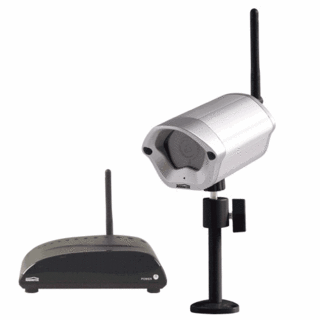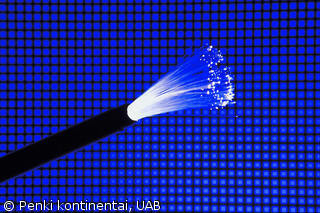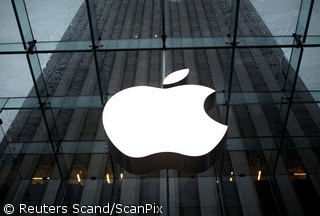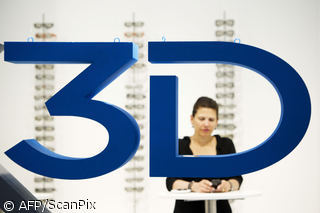JSF project puts virtual reality to its sternest real-world test.
Published:
15 October 1999 y., Friday
Wearing a VR helmet and gloves, MSNBC_s Alan Boyle gestures in front of a screen displaying an image of workers servicing the Joint Strike Fighter. Boyle_s virtual hand appears in the scene.
The high-tech warplane looms silently within a hangar. Two bombs lie on a cart, ready for loading. An olive-clad crewmate approaches me, but something seems wrong: His feet aren_t moving. Is this a dream? No, it_s reality ... virtual reality. I_m wearing a VR helmet in Seattle, and my "crewmate" is plugged in from St. Louis. The plane, the hangar, the bombs all exist only in cyberspace.
This is how the world_s next warplane, the Joint Strike Fighter, is being tested even before it_s built. It_s not just a game: Hundreds of billions of dollars are at stake for the twin giants of America_s aerospace industry. My encounter with the JSF was at the Boeing Co._s virtual reality lab in Seattle - with a cameo appearance by a Boeing technician in St. Louis. But Boeing_s rival for the JSF contract, Lockheed Martin, has established a similar setup in Fort Worth, Texas. Both companies hope that the skillful use of virtual reality - for development and testing of their prototypes as well as for training the future jet_s operators and maintainers - will give them an edge when the Pentagon names the winner of the competition in 2001. The JSF is being designed to serve as the strike fighter for the U.S. Air Force, Navy and Marines, as well as Britain_s Royal Navy and Air Force. Three configurations of the JSF would replace whole ranks of models - F-16 Falcon fighters as well as A-10 Warthog assault planes, Harrier jump jets as well as F-18 Hornets on aircraft carriers.
Copying, publishing, announcing any information from the News.lt portal without written permission of News.lt editorial office is prohibited.
The most popular articles
Software company announced new structure_ of it_s business.
more »
 Just a few weeks ago, the world's tiniest video camera was as small as a grain of rice. Today, the world's NanoEst camera is even smaller.
more »
Just a few weeks ago, the world's tiniest video camera was as small as a grain of rice. Today, the world's NanoEst camera is even smaller.
more »
 During the experiment two research groups managed to overcome a symbolic 100 TB/s optical fiber data transmission speed limit.
more »
During the experiment two research groups managed to overcome a symbolic 100 TB/s optical fiber data transmission speed limit.
more »
 Apple’s long–awaited online storage service for iTunes could be named iCloud, if only rumours are to be believed.
more »
Apple’s long–awaited online storage service for iTunes could be named iCloud, if only rumours are to be believed.
more »
 The founders of video-sharing site YouTube have bought bookmarking service Delicious from Yahoo.
more »
The founders of video-sharing site YouTube have bought bookmarking service Delicious from Yahoo.
more »
 The successful raid by hackers on Sony’s PlayStation Network is already being ranked among the biggest data thefts of all time.
more »
The successful raid by hackers on Sony’s PlayStation Network is already being ranked among the biggest data thefts of all time.
more »
 Apple has denied that its iPhones and 3G iPads have been secretly recording their owners' movements.
more »
Apple has denied that its iPhones and 3G iPads have been secretly recording their owners' movements.
more »
 Customers who have waited nearly 10 months for the white version of the iPhone 4 won’t have to wait much longer. The Great White iPhone 4 is finally here.
more »
Customers who have waited nearly 10 months for the white version of the iPhone 4 won’t have to wait much longer. The Great White iPhone 4 is finally here.
more »
 Researchers at Georgia Tech University are teaching a robot the basics of dialogue. Named "Simon", the robot has already been taught how to attract a person's attention but eventually, it's hoped he'll be able to interact and converse with humans in daily life.
more »
Researchers at Georgia Tech University are teaching a robot the basics of dialogue. Named "Simon", the robot has already been taught how to attract a person's attention but eventually, it's hoped he'll be able to interact and converse with humans in daily life.
more »
 3D? Terribly lame when it's tossed into devices as a bullet point feature. Trimensional for iPhone takes a picture of your face and maps your mug in a 3D model.
more »
3D? Terribly lame when it's tossed into devices as a bullet point feature. Trimensional for iPhone takes a picture of your face and maps your mug in a 3D model.
more »
 The European Union is to investigate whether internet service providers (ISPs) are providing fair access to online services.
more »
The European Union is to investigate whether internet service providers (ISPs) are providing fair access to online services.
more »